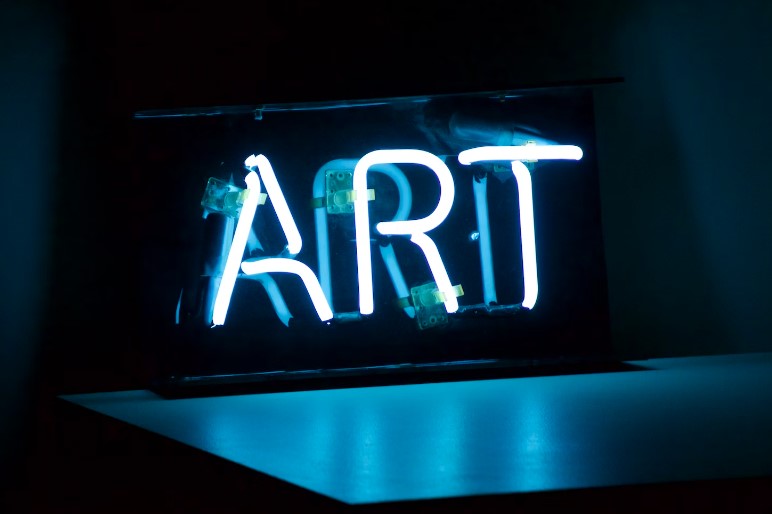
15 Aug A Brief Analysis Of Neon Signage History
If you’ve ever strolled through the vibrant streets of New York, you’ve undoubtedly been captivated by the mesmerizing glow of neon signages. These luminous creations have become iconic symbols of bustling city life and cast a radiant and enchanting light on the city that never sleeps. However, have you ever wondered when were neon signages first created? Who was the mastermind behind this innovation, and what is the history behind these luminous marvels?

We have created a comprehensive guide on neon signage history to quench your curiosity. So, without further ado, let’s embark on a fascinating journey through time to explore the captivating history of neon signs.
The Invention Of Neon Lights
You may wonder, ‘When was neon light invented?’ or ‘When was the first neon sign made?’. The invention of neon lights, or more specifically, the history of neon signs, traces right back to the 19th century, with the invention of the Geissler tube by German glassblower Heinrich Geissler in 1857. These glass tubes were filled with various gases, and when an electric current was applied, it emitted a soft glow. However, it wasn’t until the early 20th century that neon, as we know it today, came into existence. Thus, this may answer your question of ‘When were neon lights invented?’
Who invented the Neon Lights?
The credit for the modern-day neon lights goes specifically to two French inventors, Georges Claude and Jacques Fournier. In 1910, Georges Claude applied an electric discharge to neon gas enclosed in a sealed glass tube, which gave rise to the world’s first neon lamp. In this way, Claude’s innovative work paved the way for developing neon signage. All these facts must’ve now answered your question of ‘when were neon signs invented?’
Now you may wonder, ‘How did neon get its name?’ The term “neon” itself has an interesting origin. It is derived from the Greek word “neos,” meaning “new gas.” This name was chosen because neon was a new and exciting discovery at the time. However, when it comes to neon and its discovery, the answer to your question of ‘what year was neon discovered’ is 1898.
The pivotal moment for neon signs came in 1912 when Georges Claude debuted the first neon sign in Paris. This sign was used to display the word “CINÉMA” outside a theatre, which helped captivate the onlookers with its vibrant and colorful glow. So, if you ever wonder, ‘How old is neon?’, these facts will provide you with all the answers you need.
When Were Neon Signs Popular?
The introduction of neon signs significantly revolutionized advertising and urban landscapes, which had a huge part in the history of neon signs. These luminous NY Signs quickly gained popularity in the early 20th century, especially in cities like New York. By the 1920s, neon signs were adorning the facades of businesses, theatres, and hotels, transforming cityscapes into dazzling displays of art and commerce.
How Is Neon Used In Everyday Life?
Beyond its use in signage, neon has also found applications in various fields throughout the history of neon signs. For example, neon lights were once used in scientific instruments and as indicator lights in early electronics. In modern times, neon is used in lasers, television tubes, and even in producing high-voltage indicators. After knowing these facts, you will no longer have to search for ‘When were neon lights invented?’
The Age of LED Neon Signs
While the traditional neon signs remain popular and iconic, through technological advancement, they can now be seen as LED neon signs. These signs use energy-efficient LED (Light Emitting Diode) technology to mimic the appearance of neon, offering a more cost-effective and environmentally friendly alternative.
How Have Neon Signs Gained Popularity In New York?
When one thinks of neon signs, New York immediately comes to mind. Neon Signs in NY have become synonymous with the city’s vibrant culture and bustling streets. You can see this from the bright lights of Times Square to the classic “Welcome to Las Vegas” sign. This ultimately proves that neon has left an indelible mark on the cityscape.
Interesting Facts About Neon
In the world of science, very few elements capture the attention similar to neon. With its ability to create a dazzling array of colors and its iconic role in advertising, neon has left an incredible mark on both science and pop culture. Get ready to uncover unique insights about neon as we explore its intriguing history and distinctive qualities.
-
The ability to glow without heat:
Neon signs are widely known for their vivid colors, yet they remain cool to the touch. This is because, unlike incandescent bulbs, which emit heat, neon signs work by passing an electrical discharge through neon gas. This causes it to emit light without significant heat production.
-
Rainbow of colors:
While neon light itself produces a fiery red glow, the magic of neon signs lies in their ability to create a spectrum of colors. Different gases and phosphor coatings inside the tubes yield a variety of hues, from the classic red and orange to vibrant blues, greens, and purples.
-
Art and Pop Culture:
Neon signs have played iconic roles in numerous movies and cultural landmarks. Think of the famous “Welcome to Fabulous Las Vegas” sign or the neon-lit streets of Tokyo in “Lost in Translation.
“From tracing the history of neon to knowing its unique qualities, we uncovered how neon became a symbol of artistry and advertising. However, when you opt for neon signage for your business, it is important to choose the right company.
Let Vida Sign help you create captivating personalized neon business signs that will leave a lasting impression. Call 2123889388 and take the first step towards captivating neon signage.
Q&A
-
How is neon used in everyday life?
Neon is widely used in advertising signs. However, it also has applications in lasers, television tubes, and high-voltage indicators in electronics.
-
Why is neon important?
Neon’s importance lies in its distinctive ability to create vibrant and long-lasting light, making it a popular choice for eye-catching signage and decorative lighting.
-
What is neon made of?
Neon is an elemental gas, and its chemical symbol is Ne. It is a colorless, odorless, and inert gas that emits a brilliant glow when subjected to electrical discharge.
-
Where is neon most commonly found?
Neon is most commonly found in the Earth’s atmosphere, although it’s relatively rare, making up about 1 part per 65,000 in the atmosphere. It is also found in trace amounts in some minerals.

